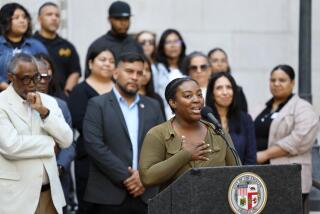Aid Helps Cash-Poor Through Home Door
- Share via
The best-kept secret behind the sustained strength of the residential real estate economy is that a new pool of buyers has been created among Americans who can afford mortgage payments but lack the cash for a down payment.
Until a few years ago, these people were trapped in a financial swamp, working two or more jobs, paying 60% of their incomes for rent, saving nothing. They were effectively shut out of homeownership.
Not surprisingly, this phenomenon tends to trap many minorities.
The Department of Housing and Urban Development reported in July that, largely because of the lack of down-payment assistance, the rate of minorities who owned homes continued to lag behind the rate of whites.
This is important not only for those locked out of the American dream but for the rest of us as well: The Bush administration and the Federal Reserve have recognized that down-payment assistance is the key to driving up the homeownership rate while re-energizing the economy.
A new concept in residential real estate that uses private capital provided through nonprofit organizations for down-payment assistance can help loan-qualified but cash-poor buyers. These programs bring together down-payment charities, real estate professionals, homebuilders, lending institutions, buyers and sellers. In a typical transaction, down-payment and closing money is fronted by a charitable fund pool.
The down-payment gift industry now makes possible nearly 20% of the Federal Housing Administration-insured single-family home transactions in the United States. Without that extra boost, our economy would be in much worse shape.
At the White House Conference on Minority Homeownership last month, President Bush recognized the need to help poor people overcome the down-payment “hurdle” and endorsed an American Dream Down Payment Fund. The proposed $200-million program would allow qualified low- and moderate- income applicants to use federal grants to cover down payments or closing costs.
The proposal to establish the fund comes after the Federal Reserve Bank in Minneapolis recommended that Fannie Mae and Freddie Mac, the private mortgage investment companies chartered by Congress, reallocate mortgage-interest subsidies commonly provided to low-to-moderate-income borrowers and use some of the money for down-payment assistance.
The program is a way for the government to jump into the effort to drive up homeownership in this new pool of buyers. But the $200 million a year that the administration has pledged for down-payment aid won’t be enough to accomplish the president’s goal of lifting 5.5 million minority families into homeownership by decade’s end.
Using private capital, the nonprofit down-payment gift industry now makes possible about 17,000 home transactions a month for low- and moderate-income buyers.
Assuming an average down-payment grant of $5,000 through the new Bush program, no more than an additional 3,300 homes a month would be sold. That is not nearly enough. To achieve the administration’s goal, the government should work with the existing private capital sources. As the president has said, government cannot do it alone.
The new federal down-payment assistance policy and the successful ongoing work of the nonprofit down-payment gift industry are focused on the same goal. This may turn out to be one of the most successful public-private partnerships in the history of residential real estate.
More to Read
Inside the business of entertainment
The Wide Shot brings you news, analysis and insights on everything from streaming wars to production — and what it all means for the future.
You may occasionally receive promotional content from the Los Angeles Times.










